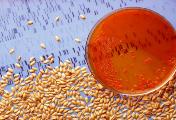Differentiating your product in the
marketplace
Freshness, perfect ripeness or artisan care in the manufacturing
process, are some of the many ways in which products stand
out in the marketplace. For olive oil, producers can rely on
standardized yardsticks that provide an objective measure of
quality, thus enabling product differentiation.
Quality standards defined by the International Olive Council
(IOC) have been adopted by the state of California, which has
imposed labeling compliance on all olive oil sold within the state.
Also, the California Olive Oil Council (COOC) grants a Seal for
Extra Virgin Oil to guarantee product quality to consumers, ruling
out mislabeling or adulteration.
At Agbiolab, we provide the analytical tests required both by the
state of California and the COOC. Our expanded facilities enable
us to provide you with accurate results to help you get the
maximum differentiation for your product and assure the quality
of your olive oil to your buyers.
|
|
Protecting your investment
Timely quality information is always critical for making business
decisions. In agribusiness, where investments of thousands and
often millions of dollars can be compromised by devastating
plant diseases or by the unchecked presence of genetically
modified organisms, the need for information is very real.
Biotechnology provides fast and reliable means of identifying
pathogens, plants or rootstocks varieties, or of detecting the
presence of genetically modified organisms (GMO) in marketed
goods. For instance, testing samples of wood or foliar tissue
taken from multiple individual plants can reveal the advance of a
particular infestation across an orchard.
Our testing services include:
• Plant disease diagnosis
• GMO detection
• Contract research
At Agbiolab, we are set up to guide you through the process of
taking and submitting samples. We guarantee careful handling
of the samples. Our facilities enable us to provide you with rapid
and accurate results, which will allow you to make reliable and
informed business decisions.
|
|
 |
|
|
|
Pathogen detection:
Consider the enormous
devastation caused a few
years back by Pierce’s
Disease (Xylella fastidiosa)
in Temecula Valley
vineyards: 40% of the
vines were affected and
whole vineyard blocks had
to be removed.
Early detection of vines
infected by the Xylella
fastidiosa bacterium, and
eradication of infected
plants to control disease
spread would have
mitigated the high costs
inflicted by this disease on
vineyards and growers.
|
|
|



